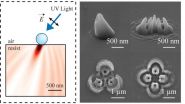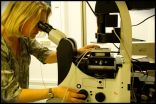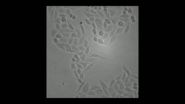(Press-News.org) Researchers from North Carolina State University have developed a new lithography technique that uses nanoscale spheres to create three-dimensional (3-D) structures with biomedical, electronic and photonic applications. The new technique is significantly less expensive than conventional methods and does not rely on stacking two-dimensional (2-D) patterns to create 3-D structures.
"Our approach reduces the cost of nanolithography to the point where it could be done in your garage," says Dr. Chih-Hao Chang, an assistant professor of mechanical and aerospace engineering at NC State and senior author of a paper on the work.
Most conventional lithography uses a variety of techniques to focus light on a photosensitive film to create 2-D patterns. These techniques rely on specialized lenses, electron beams or lasers - all of which are extremely expensive. Other conventional techniques use mechanical probes, which are also costly. To create 3-D structures, the 2-D patterns are essentially printed on top of each other.
The NC State researchers took a different approach, placing nanoscale polystyrene spheres on the surface of the photosensitive film.
The nanospheres are transparent, but bend and scatter the light that passes through them in predictable ways according to the angle that the light takes when it hits the nanosphere. The researchers control the nanolithography by altering the size of the nanosphere, the duration of light exposures, and the angle, wavelength and polarization of light. The researchers can also use one beam of light, or multiple beams of light, allowing them to create a wide variety of nanostructure designs.
"We are using the nanosphere to shape the pattern of light, which gives us the ability to shape the resulting nanostructure in three dimensions without using the expensive equipment required by conventional techniques," Chang says. "And it allows us to create 3-D structures all at once, without having to make layer after layer of 2-D patterns."
The researchers have also shown that they can get the nanospheres to self-assemble in a regularly-spaced array, which in turn can be used to create a uniform pattern of 3-D nanostructures.
"This could be used to create an array of nanoneedles for use in drug delivery or other applications," says Xu Zhang, a Ph.D. student in Chang's lab and lead author of the paper.
The new technique could also be used to create nanoscale "inkjet printers" for printing electronics or biological cells, or to create antennas or photonic components.
"For this work, we focused on creating nanostructures using photosensitive polymers, which are commonly used in lithography," Zhang says. "But the technique could also be used to create templates for 3-D structures using other materials."
The researchers are currently looking at several additional ways to manipulate the technique to control the shape of resulting structures.
"We're exploring the use of nanosphere materials other than polystyrene, as well as nanoparticle shapes other than spheres," Chang says. "And ultimately we want to look at ways of controlling the placement of particles on the photosensitive film in patterns other than uniform arrays."
INFORMATION:
The paper, "Sculpting Asymmetric Hollow-Core Three-Dimensional Nanostructures Using Colloidal Particles," was published online Dec. 8 in the journal Small. The paper was co-authored by undergraduates Bin Dai and Zhiyuan Xu, who worked on the project at NC State as part of the Global Training Initiative (GTI) program with Jiangsu University. The work was supported by NASA Early Career Faculty grant number NNX12AQ46G and by the Nanosystems Engineering Research Center for Advanced Self-Powered Systems of Integrated Sensors and Technologies at NC State under National Science Foundation grant number EEC-1160483.
Nature's ingenious systems: A layer of cells called endothelial cells lines the interior of blood vessels. When blood flows through the vessels, such cells only divide to replace dead cells. However, if there is a blood clot preventing blood from flowing across the endothelial cells, they begin to divide more actively. New research from the Niels Bohr Institute demonstrates that cell division is very ordered. The new cells move away from each other and create a dynamic movement with eddies in a large area. This presumably helps to widen the vessel around the blockage. The ...
A new study by researchers at the University of Exeter has found early warning signals of a reorganisation of the Atlantic oceans' circulation which could have a profound impact on the global climate system.
The research, published today in the journal Nature Communications, used a simulation from a highly complex model to analyse the Atlantic Meridional Overturning Circulation (AMOC), an important component of the Earth's climate system.
It showed that early warning signals are present up to 250 years before it collapses, suggesting that scientists could monitor ...
Cancer Research UK scientists have discovered a new line of defence used by cancer cells to evade cell death, according to research published in Nature Communications* today (Monday).
The team identified a critical pathway of molecular signals which throw a lifeline to cancer cells, enabling them to survive even though they contain vast DNA errors which would usually trigger cell death.
The PKCƐ signal pathway**, which is used by cancer cells but rarely by normal cells, could be important in targeting some cancer cells as they rely on this pathway to survive.
The ...
UPTON, NY-A team of scientists from the U.S. Department of Energy's (DOE) Brookhaven National Laboratory, Columbia Engineering, Columbia Physics and Kyoto University has discovered an unusual form of electronic order in a new family of unconventional superconductors. The finding, described in the journal Nature Communications, establishes an unexpected connection between this new group of titanium-oxypnictide superconductors and the more familiar cuprates and iron-pnictides, providing scientists with a whole new family of materials from which they can gain deeper insights ...
A new analysis has found that while clinical trial data support omitting radiation treatments in elderly women with early stage breast cancer, nearly two-thirds of these women continue to receive it. The findings are published early online in Cancer, a peer-reviewed journal of the American Cancer Society.
Results published in 2004 from a large, randomized clinical trial showed that adding radiation therapy to surgery plus tamoxifen does not reduce 5-year recurrence rates or prolong survival in elderly women with early stage tumors. Despite the findings, many doctors still ...
DURHAM, N.C. - Women over the age of 70 who have certain early-stage breast cancers overwhelmingly receive radiation therapy despite published evidence that the treatment has limited benefit, researchers at Duke Medicine report.
The study suggests that doctors and patients may find it difficult to withhold treatment previously considered standard of care, even in the setting of high quality data demonstrating that the advantages are small.
"The onus is on physicians to critically analyze data to shape our treatment recommendations for patients, weighing the potential ...
Dublin, IRELAND Monday December 8th, 2014 - Millions of documents stored in archives could provide scientists with the key to tracing agricultural development across the centuries, according to new research completed at Trinity College Dublin and the University of York.
Amazingly, thanks to increasingly progressive genetic sequencing techniques, the all-important historical tales these documents tell are no longer confined to their texts; now, vital information also comes from the DNA of the parchment on which they are written.
Researchers used these state-of-the-art ...
Metabolic syndrome is linked with an increased frequency and severity of lower urinary tract symptoms, but weight loss surgery may lessen these symptoms. The findings, which come from two studies published in BJU International, indicate that urinary problems may be added to the list of issues that can improve with efforts that address altered metabolism.
Lower urinary tract symptoms related to urinary frequency and urgency, bladder leakage, the need to urinate at night, and incomplete bladder emptying are associated with obesity in both men and women. To see if these ...
HANOVER, N.H. - December 8, 2014 - With health systems in the U.S., U.K., and around the world trying to increase vaccination levels, it is critical to understand how to address vaccine hesitancy and counter myths about vaccine safety. A new article in the journal "Vaccine" concludes, however, that correcting myths about vaccines may not be the most effective approach to promoting immunization among vaccine skeptics. The study, which was co-authored by Brendan Nyhan, an assistant professor of government at Dartmouth College, and Jason Reifler, a senior lecturer of politics ...
SAN FRANCISCO - The latest results of clinical trials of more than 125 patients testing an investigational personalized cellular therapy known as CTL019 will be presented by a University of Pennsylvania research team at the 56th American Society of Hematology Annual Meeting and Exposition. Highlights of the new trial results will include a response rate of more than 90 percent among pediatric acute lymphoblastic leukemia patients, and results from the first lymphoma trials testing the approach, including a 100 percent response rate among follicular lymphoma patients and ...




